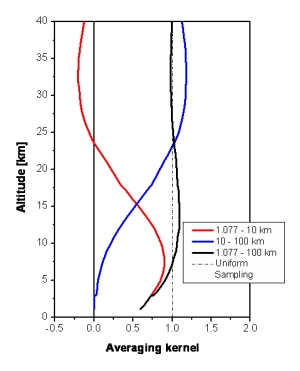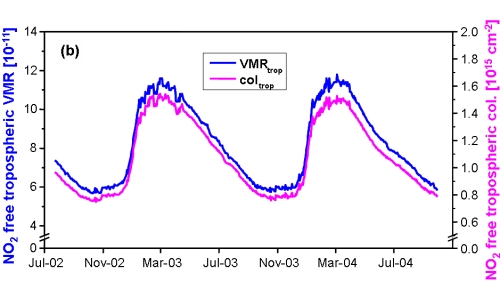Results: New Method for Retrieval of Tropospheric NO2 via Synergetic Use of Satellite Data and Ground-Based FTIR? First Annual Cycle of Free Tropospheric NO2
Interest in the climatic role of tropospheric NO2 has shown up only recently, when it has been found that a significant radiative forcing (exceeding that of CO2) can build up during periods with extremely elevated NO2 levels in the troposphere (Solomon et al., 1999).
Therefore we present an original concept to infer tropospheric NO2 via a combined retrieval from satellite NADIR DOAS and ground-based solar FTIR measurements [Sussmann et al., 2005]. We will show in this paper how to use a FTIR mountain site as a reference for combined satellite retrievals of tropospheric NO2 over land. This is a complementary approach in addition to the traditional method using stratospheric reference columns retrieved over sea. The latter is based on the assumption of a longitudinally homogeneous stratospheric NO2 layer. Variations can, however, clearly not be neglected close to the Polar Vortex or during major changes in stratospheric dynamics. For demonstration, FTIR measurements performed at the Zugspitze, Germany in the time span July 2002 - October 2004 were used synergistically with columnar NO2 retrieved from ENVISAT/SCIAMACHY data by the University of Bremen scientific algorithm UB1.5.
We found that FTIR gives a nearly unbiased (< 25 % maximum bias in case of extreme tropospheric pollution, clean air bias < 1 %) and highly precise measure of the pure stratospheric column (precision of the daily mean or virtual-coincidence column 4.3 %). This is achieved using an a priori profile with the tropospheric part set to zero and is true to a best approximation for a mountain station which is located above the boundary layer.
Using Zugspitze FTIR soundings set up in this way, we have formulated a combined a posteriori retrieval of FTIR and SCIAMACHY for the tropospheric column, based upon the averaging kernels. It yields two independent pieces of information, i.e., the tropospheric and stratospheric columns, respectively.

This combined retrieval was performed under the simplifying assumption that SCIAMACHY and FTIR are operating without intrinsic errors, i.e., the observed differences between SCIAMACHY and FTIR are only due to tropospheric NO2. It yields an annual cycle of the clean background (free) tropospheric column (<10 km) with variations between 0.74-1.23E+15 cm-2, an average of 0.96E+15 cm-2, and an intermediate phase between that of the well known boundary layer and stratospheric annual cycles.

Reference
Sussmann, R., Stremme, W., Burrows, J.P., Richter, A., Seiler, W., and Rettinger, M.: Stratospheric and tropospheric NO2 variability on the diurnal and annual scale: a combined retrieval from ENVISAT/SCIAMACHY and solar FTIR at the Permanent Ground-Truthing Facility Zugspitze/Garmisch, Atmos. Chem. Phys., 5, 2657–2677, 2005 ![]() .
.
